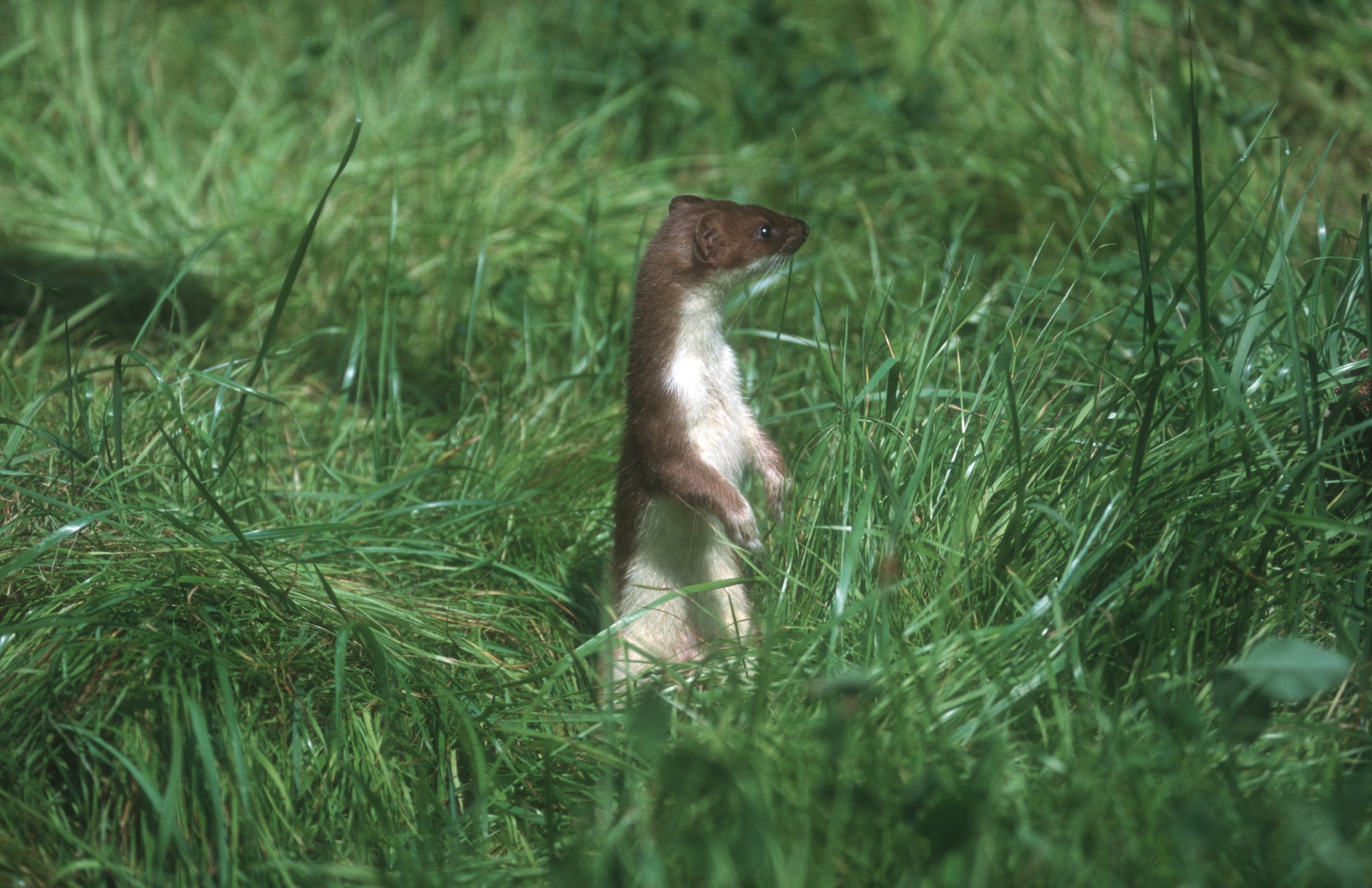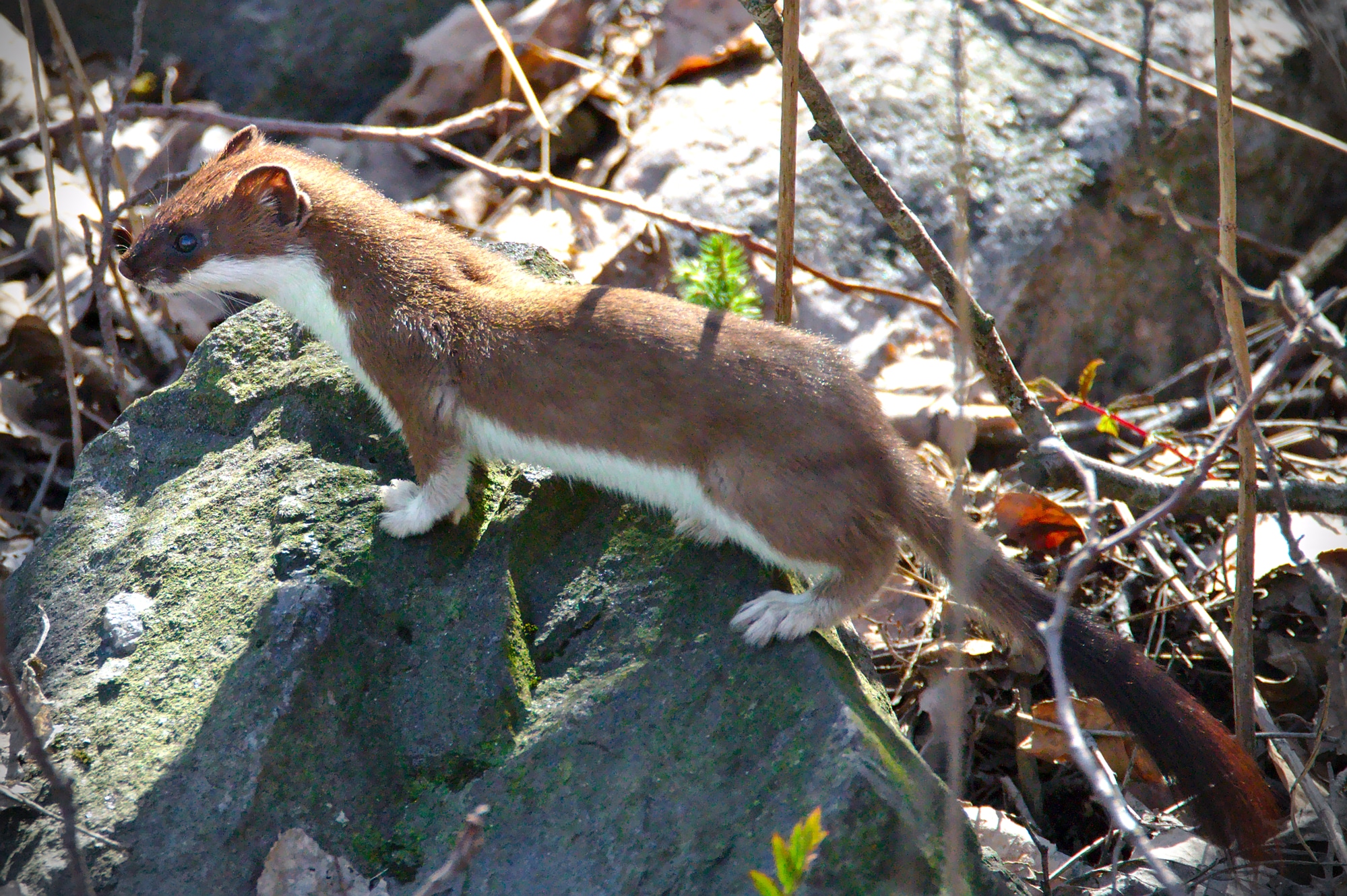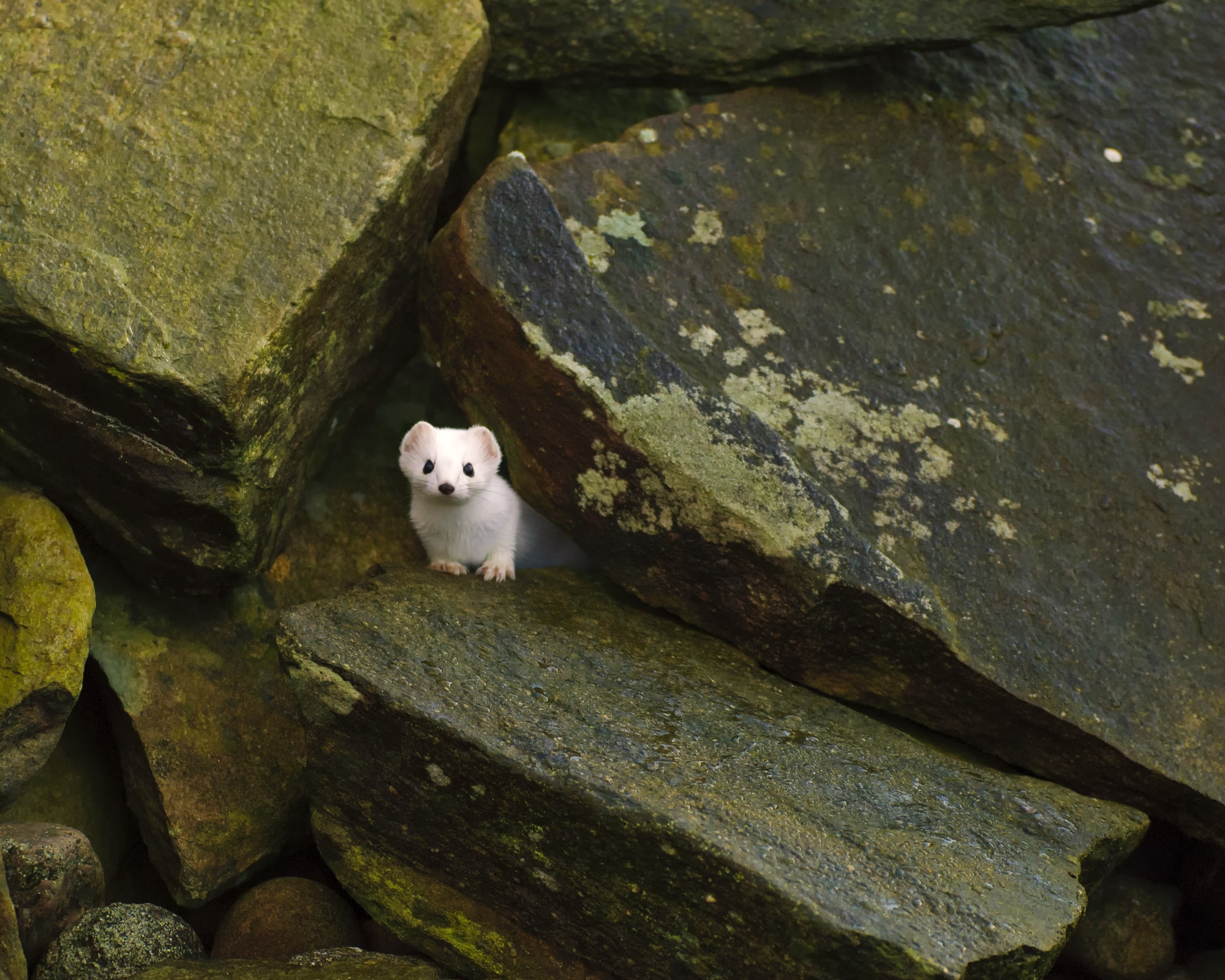Stoats (scientific name Mustela erminea) are medium-sized carnivores belonging to the Mustelidae family. They have a low slung body, short legs, and a long, thin neck and typically live in dens near open water. Stoats are native to Europe, Asia, parts of Africa, and North America. Although they are similar in general body shape to weasels, they are not members of the same family. They are sometimes referred to as polecats.
What Does A Stoat Look Like?

The stoat is a mammal with soft thick fur and short legs. The stoat has a triangular head with a pointed snout and small ears that fold forward when it is alert. The eyes are small and set close together; the nose is short, black, and usually hidden in the fur.
Fur and Colour
Aside from when the stoat has its white winter coat, the fur is coarse and can range widely in appearance, usually a mix of orangey brown, yellow, buff, chestnut, and black, with perhaps a creamy white throat. The mix of colours can differ a great deal, with some having only a single colour such as a completely white (they change colour and turn white in winter) or orange body. There are no markings across the upper parts of the body length (snowy white or pale grey), but sometimes a black tip to the hairs appears on the back and tail in summer. The underside is pale, with few markings other than a line down each leg.
Males vs Females
Female stoats have a slightly longer and thinner body than males with less fur. The head has a prominent facial shield of black fur surrounded by a white area on the forehead, chin, lower cheeks, and jaw.
Tail
The tail of a stoat can have just a black tip or be all black or tan. The tail is short and narrow, and it is usually held horizontally in a stoat’s posture of alertness.
What Is The Difference Between A Stoat And Weasel?

The stoat (Mustela erminea) is larger and stockier than a weasel (Mustela nivalis). They are about twice as heavy as a weasel, but they both have the same shape. Unlike weasels, the stoat has longer tails, ears, and snouts. The stoat’s colour is usually lighter than that of the weasel. A Least Weasel usually has pale-tipped guard hairs on its tail and back that gives them their sharp appearance and makes them look like they have “whiskers”.
Are Stoats Aggressive?
Stoats are one of the animals most likely to carry rabies in Europe (along with foxes; raccoons are third). In other countries, they do not pose a threat. They are capable of inflicting a lot of damage, but their natural tendency is to avoid confrontation. In some parts of the world, it will attack and may easily kill its victim and larger prey by biting it on the face, neck, or back.
They attack mainly at dusk and dawn when they are less likely to be noticed. Occasionally they will attack if they feel threatened by dogs. They are more aggressive in the winter months, as during this time of year, they tend to live on agricultural land due to the scarcity of alternative food.
Do Stoats Attack Humans?
Stoats often live in close proximity to humans but seldom become very aggressive unless provoked. They are shy and prefer to remain hidden away from humans. Occasionally they may become aggressive if they feel threatened by human or other predators. And Since they are rarely kept as pets, attacks on humans are very low in numbers.
Are Stoats Solitary Animals?

Stoats remain solitary except for when mating season occurs (usually between late March and June). They often mate with a single partner and remain monogamous for multiple seasons. The male stoat leaves his home range to find a female after mating season is over, but the female remains in her range until her young are born in the spring or summer.
What Do Stoats Eat?
Stoats are carnivores, so their diet consists primarily of meat from small rodents. However, being efficient hunters, The range of food that the stoat eats is quite large. It will feed on small mammals, such as rabbits, and is particularly known for hunting small rodents such as mice and rats. It will also feed on frogs, birds, bird eggs, insects such as dragonflies and crickets. They have been known to even prey on larger animals like an adult rabbit, baby deer, or livestock in times of hardship, such as winter.
Can You Have A Stoat As A Pet?
It is not legal to keep a stoat as a pet in most countries, either because they are a protected species or because they are too hard to look after. They are not legal to keep as pets in the USA because they are listed as high-risk.
If kept in captivity, the stoat can become stressed because of the lack of their natural hunting grounds and other sources of food. Stoats as pets are also able to carry some diseases that can infect their owners. It is legal to purchase a stoat in the UK as long as they are not released into the wild.
Stoats will not be very friendly with your other pets. They are very vicious of the mammal society, so they won’t get along well with other domestic pets, especially rabbits. If you want a pet that is similar to the stoat but easier to look after, then look at a tamed weasel as a pet.
In What Types Of Habitats Do Stoats Live?

Although the stoat is widespread in mainland Britain, Scottish Islands, and the Channel Islands, stoats live in various habitats abundant in wildlife, from tundra to forests and even rainforests. They prefer open habitats with abundant ground cover, such as shrubs and ground vegetation. This small predator will also live in more open areas, especially if they are hunting for small mammals. They like to live in an area that provides cover for them, such as fallen logs and rocks. The stoat prefers forests with small prey such as water voles and lemmings, which is the prey they’re usually looking for.
Sources and References
- Species – Stoat – mammal.org.uk
- Stoat – woodlandtrust.org.uk
Sam loves to learn about animals and their habitats. He has been a nature lover from a very young age, and has been writing papers and articles about wildlife for as long as he can remember.

Thanks for answering my question “are stoats dangerous to humans?” I couldn’t get the answer from any other website. I have a stoat that is constantly running and leaping about in my front garden near my pond. It looks like it’s having great fun. I was worried it may try to get into my house as it came very near my front door yesterday when it was open. I also look after my daughters French bulldog from time to time and am slightly concerned it may attack it if chased.
Hi Evelyn, glad to be of help.
Our cat dragged a weasel/stoat home dead yesterday, which surprised us as we have had cats as pets for over 40 odd years and apart from the usual bird, mouse never this. We have lived in the same place since 1979, and I have never come across them while out walking in all that time, Should I be concerned or report it to a wildlife organisation near us? I did get my husband to take a picture of it as it has now vanished from the garden. Any help would be appreciated.